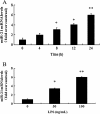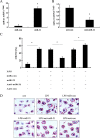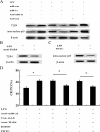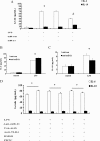miR-21 attenuates lipopolysaccharide-induced lipid accumulation and inflammatory response: potential role in cerebrovascular disease
- PMID: 24502419
- PMCID: PMC3922422
- DOI: 10.1186/1476-511X-13-27
miR-21 attenuates lipopolysaccharide-induced lipid accumulation and inflammatory response: potential role in cerebrovascular disease
Abstract
Background: Atherosclerosis constitutes the leading contributor to morbidity and mortality in cardiovascular and cerebrovascular diseases. Lipid deposition and inflammatory response are the crucial triggers for the development of atherosclerosis. Recently, microRNAs (miRNAs) have drawn more attention due to their prominent function on inflammatory process and lipid accumulation in cardiovascular and cerebrovascular disease. Here, we investigated the involvement of miR-21 in lipopolysaccharide (LPS)-induced lipid accumulation and inflammatory response in macrophages.
Methods: After stimulation with the indicated times and doses of LPS, miR-21 mRNA levels were analyzed by Quantitative real-time PCR. Following transfection with miR-21 or anti-miR-21 inhibitor, lipid deposition and foam cell formation was detected by high-performance liquid chromatography (HPLC) and Oil-red O staining. Furthermore, the inflammatory cytokines interleukin 6 (IL-6) and interleukin 10 (IL-10) were evaluated by Enzyme-linked immunosorbent assay (ELISA) assay. The underlying molecular mechanism was also investigated.
Results: In this study, LPS induced miR-21 expression in macrophages in a time- and dose-dependent manner. Further analysis confirmed that overexpression of miR-21 by transfection with miR-21 mimics notably attenuated lipid accumulation and lipid-laden foam cell formation in LPS-stimulated macrophages, which was reversely up-regulated when silencing miR-21 expression via anti-miR-21 inhibitor transfection, indicating a reverse regulator of miR-21 in LPS-induced foam cell formation. Further mechanism assays suggested that miR-21 regulated lipid accumulation by Toll-like receptor 4 (TLR4) and nuclear factor-κB (NF-κB) pathway as pretreatment with anti-TLR4 antibody or a specific inhibitor of NF-κB (PDTC) strikingly dampened miR-21 silence-induced lipid deposition. Additionally, overexpression of miR-21 significantly abrogated the inflammatory cytokines secretion of IL-6 and increased IL-10 levels, the corresponding changes were also observed when silencing miR-21 expression, which was impeded by preconditioning with TLR4 antibody or PDTC.
Conclusions: Taken together, these results corroborated that miR-21 could negatively regulate LPS-induced lipid accumulation and inflammatory responses in macrophages by the TLR4-NF-κB pathway. Accordingly, our research will provide a prominent insight into how miR-21 reversely abrogates bacterial infection-induced pathological processes of atherosclerosis, indicating a promising therapeutic prospect for the prevention and treatment of atherosclerosis by miR-21 overexpression.
Figures




References
-
- Hellings WE, Peeters W, Moll FL, Piers SR, van Setten J, Van der Spek PJ, de Vries J-PP, Seldenrijk KA, De Bruin PC, Vink A. Composition of carotid atherosclerotic plaque is associated with cardiovascular outcome a prognostic study. Circulation. 2010;121:1941–1950. doi: 10.1161/CIRCULATIONAHA.109.887497. - DOI - PubMed
Publication types
MeSH terms
Substances
LinkOut - more resources
Full Text Sources
Other Literature Sources

